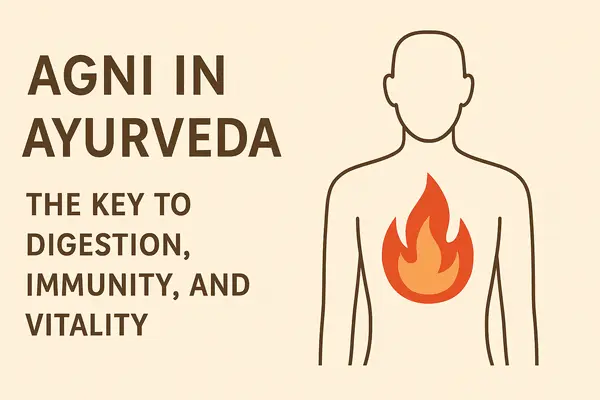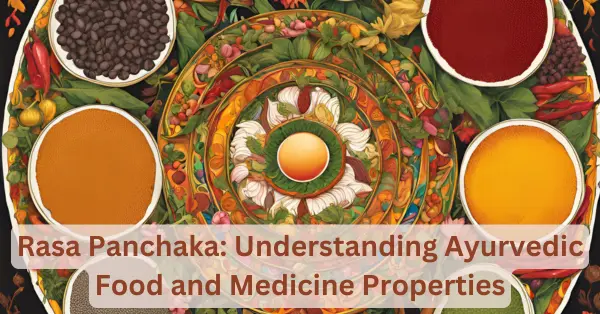In this blog, we will comprehensively go through all the aspects of Agni or digestive fire in Ayurveda.
Agni is a Sanskrit word that denotes fire. In Ayurveda, it represents the body’s digestive fire. This force drives digestion and metabolism and contributes to growth and development.
Agni is the force of intelligence within each cell, each tissue, and every system within the body.[1]
In other words, Agni is the metabolic process of transforming food into nutrients, energy and waste. It is not limited to the digestive system, but it extends to mental processing and cellular metabolism.
“Shante Agnou Mriyate,
Yukte Chiram Jivatyanamaya”
Meaning– When the Agni is extinguished, the body is considered dead. When Agni is in balance, a person lives long without ailment.
Function of Agni in the body
- Agni digests the food.
- Nourishes the doshas or biological energies (vata, pitta, and kapha).
- Nourishes Dhatus
- Growth and development of the body
“We are not what we eat, we are what we digest.”
Ayurveda Saying
Ama in Ayurveda
The word Ama means “uncooked, raw, or undigested”.
To better understand the Agni, let’s briefly understand Ama. When the Agni becomes impaired, it produces a toxin called Ama. Simply put, Ama is the opposite of Agni. It is a Toxic by-product of incompletely digested food.
It is a form of unmetabolized waste that is neither utilised by the body nor excreted by the body.
When it accumulates in the body in large quantities, Ama aggravates the three (Vata, Pitta, and Kapha) doshas, which are responsible for most diseases.
Qualities of Ama
Qualities of Ama are opposite of the digestive fire or agni.
Agni qualities- Hot, Sour, Light, and Dry.
Ama qualities- Cold, Dull, Heavy, and Oily
Foods that decrease the Agni, will increase the Ama in the body.
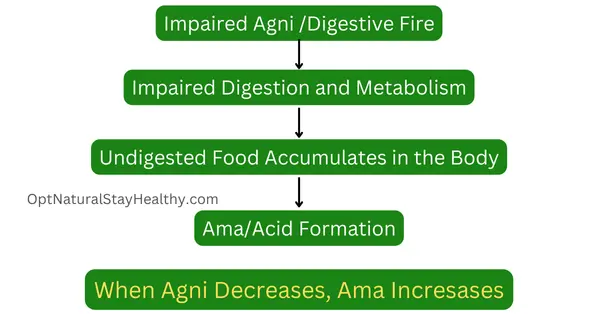
13 Types of Agni in Ayurveda
Agni is divided into 13 types based on function and site of action.
1 Jathragni
5 Bhutagni
7 Dhatuagni
Jathragni
Jathragni can be correlated to the digestive fire or the biological energy present in the duodenum. It acts upon the food we eat to digest and divide the food into essential portions and waste products (faeces, urine, sweat).
Jatharagni plays a key role in the digestion of food-stuffs composed of the five basic elements and transforms them for utilisation by the respective tissues.[2]
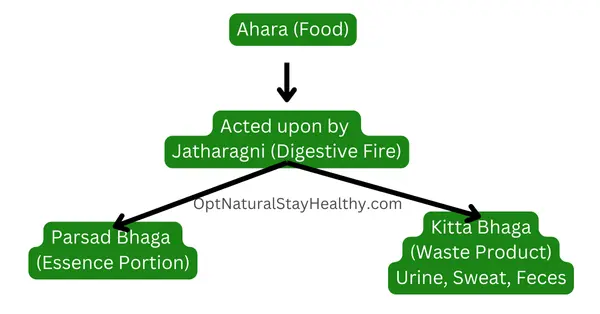
Bhutagni
- There are 5 bhutagnis present in the five elements of the body.
- Acts after the action of Jatharagni
- Each Bhutagni digests its part, and thus the digested portion of the body’s food channels nourishes the tissues.
- This process of Bhutagnis can be correlated to the conversion of digested material in the liver.
Dhatuagni
- All seven Dhatus contain their agni to metabolise nutrients supplied to them.
- Helps in the formation, nourishment, and maintenance of tissues.
- Dhatuagni also helps eliminate tissue toxins.
4 States of Agni
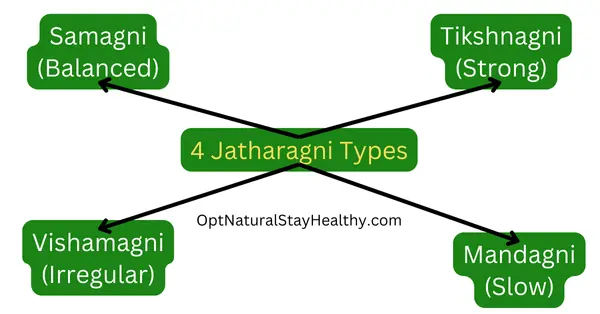
1. Samagni (Balanced Agni)
- Digests food well
- Balanced digestion, balanced absorption, and elimination
- People with Samagni are healthy.
2. Vishamagni (irregular digestion)
- Excess Vata
- Erratic digestion
- Irregular appetite, indigestion, and abdominal distention. Constipation is common.
- It can cause Ama formation (black coating on the tongue)
3. Tikshnagni (Hypermetabolism)
- Excess Pitta
- Too hot or too sharp, Agni
- Excess intensity in the digestive fire
- The desire for a large quantity of food
- Gastritis, acidity, heartburn, and dry mouth
- Can cause ama formation (Yellow coating on the tongue)
4. Mandagni (hypo-metabolism)
- Excess Kapha
- Underactive, dull, sluggish digestion
- Unable to digest even small amounts of food.
- Less appetite, slow metabolism
- Heaviness in the stomach
- Frequent cold, cough, and congestion in the body.
“Rogah Sarveapi Mandagnou”
Rogah = disease, Sarveapi = all, Mandagnou= due to slow digestion
All the diseases are caused by Mandagnou or slow digestion.
Explanation- Food doesn’t get digested because of the Mandagni, hence the food doesn’t get divided into the essential and waste product parts. It accumulates in the body and results in the formation of a substance called “Ama”
Foods to Balance Agni in Ayurveda
1. Vishamagni
Follow a Vata pacifying diet of warm nature. Plenty of root vegetables and healthy fats also help.
2. Tikshanagni
Follow a pitta-pacifying diet of cooling nature, hydrating food, and juicy fruits.
Avoid spicy and pungent foods like onions and garlic.
3. Mandagni
Follow a kapha pacifying diet of light, stimulating foods such as steamed vegetables and spices.
Avoid dairy, sugar, fatty, and fried foods.
4. Samagni
This is the balanced and desirable state of the agni. Follow the diet as per the season’s dosha dominance.
Signs of Imbalanced Agni
- Constipation, Bloating, and Indigestion.
- Mood Swings and Mental Fog.
- Coated Tongue and Bad Breath
- Fatigue and Lethargy
- Overall dullness
- Skin Issues
How to balance Agni
Once we have detected an imbalance, it’s quite easy to balance Agni. Just remember the following points.
1. Eat warm, light, and easy-to-digest food.
2. Take 3-4 hours gap between the meals.
3. Eat only when hungry
4. Take a short walk before eating
5. Drink warm water when waking up in the morning.
6. Maintain proper hydration
7. Eat your biggest meal at lunch
8. Chew your food slowly and well.
9. Drink only one to two sips of water before eating meals.
10. Do not drink chilled water. It suppresses the digestive fire.
11. After eating meals, wait for at least one hour and then you can drink water.
12. Eat fibre-rich foods.
13. Include vitamin C in your diet
14. Short walk after meals.
15. Lying on the left side after meals stimulates the digestion.
16. You can also practice Vajrasana right after the meals.
17. Include spices like pepper, cardamom, cumin, and cinnamon. These spices stimulate the secretion of saliva and digestive enzymes in the stomach.
18. Hing is also an effective spice remedy for weak digestion.
19. Take a piece of fresh ginger with a few drops of lemon juice before eating meals. This ignites the agni and stimulates the digestion of food.
20. Exercise and do pranayama
21. Cleanse the body of Ama or toxins by digestive cleaning, which can be done following-
a) Full-day water diet
b) Fruit or Fruit Juice diet
c) Eating Khichdi (rice and moong dal) for the full day.
Conclusion
Agni is a metaphorical flame that sustains life. By understanding the concept of agni, you can lead a healthy life full of harmony, balance, and clarity.
Also, all seven Dhatus (seven element tissues of the body) contain their own Agni to metabolise the nutrient materials supplied to them through their own Srotas or source.[3]
Reference
[1] Dr. Gaurav Mishra, Kumar Ashvini, Sharma Swati. Concept of Agni and its Importance in Ayurveda: A Review. J Ayurveda Integr Med Sci [Internet]. 2017Jun.30 [cited 2025Jul.7];2(03):184-8. Available from: Link to Study. <Go to Citation>
[2] Halgekar P, K N Rajashekhar, Gayathri Holla. Agni a Biotransformer. J Ayurveda Integr Med Sci [Internet]. 2024Jul.22 [cited 2025Jul.7];9(5):52 -58. Available from: Link to Study. <Go to Citation>
[3] Agrawal AK, Yadav CR, Meena MS. Physiological aspects of Agni. Ayu. 2010 Jul-Sep;31(3):395-398. Available from: Link to Study. <Go to Citation>

